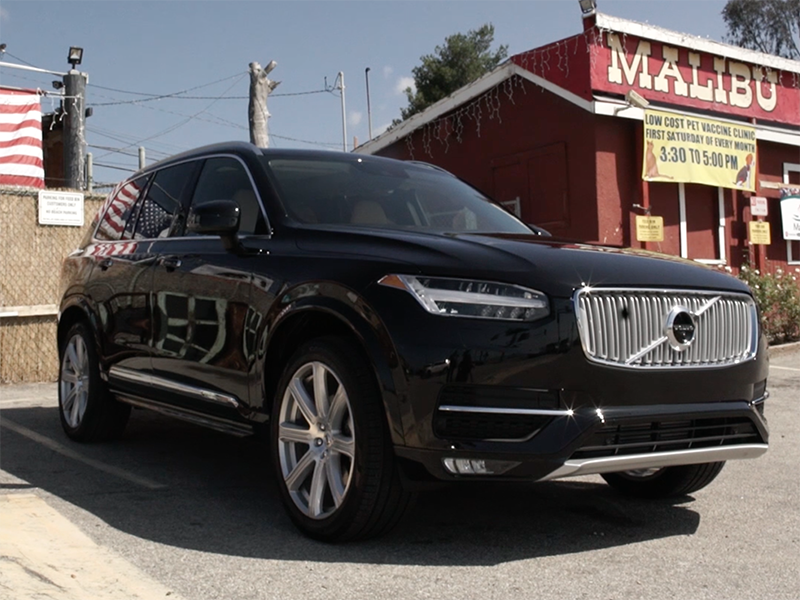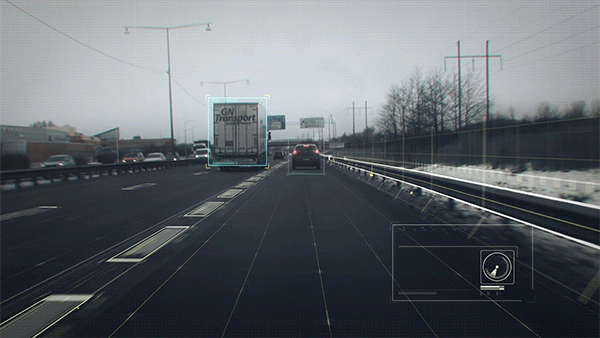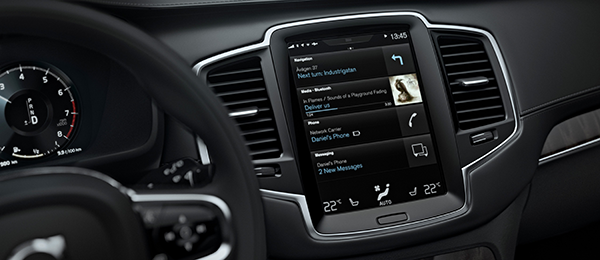Look Ma, No Hands! Volvo's Amazing Car Tech
The Volvo XC90 is one of the smartest SUVs yet, complete with a pilot assist system an iPad-like touch screen.

For Volvo, the road to zero car fatalities is paved with technology. The company's long-awaited XC90 is the first vehicle to feature Volvo's new engineering and technology platform, and it's loaded with safety- and driver-assistance technology. It's been more than a dozen years since Volvo revamped its SUV, and those looking for a state-of-the-art people mover will find it was worth the wait.
On a sunny day in California, I test-drove the XC90, an SUV with luxurious appointments, semi-autonomous driver-assistance features and a new touch-screen connected car system. The T6 Inscription all-wheel-drive model starts at $48,900, but the fully loaded version I had (including all the safety tech, 21-inch wheels and a premium sound system) topped out at $66,705.
The Drive
The XC90 is a seven-seater, with rear and third-row seats that fold flat for cargo hauling. The interior, with butter-soft leather and front seats that can be electronically adjusted to fit nearly any physique (even the side bolsters have electronic controls), follows a "theater" seating design, which means the rear seats sit progressively higher so that occupants in the back have a clear forward view. It also means that the third row is really only for kids or adults under 5'6".

In city traffic, highway cruising and on sinuous mountain roads, the XC90's electronically assisted steering is precise and not too ponderous. The seats keep you comfortably planted even as the driver takes liberties with the posted speed limit. The XC90 is no sports car, but corner roll is kept to a minimum in all driver-adjustable modes (the version I tested had the optional air-suspension system). There are three settings for comfort, highway and sports handling.
The supercharger keeps the turbo lag down to a minimum; most drivers won't notice any particular hesitation in acceleration (it takes 6.1 seconds to get from 0 to 60 mph). Compared to BMW's X5, the Volvo SUV doesn't feel as light on its feet, but it does convey the confidence of being more solidly stuck to the road.
The Driving Tech
Volvo has crammed a ton of safety features into the XC90, including a cross-traffic braking system to prevent left-hand turn crashes, revamped seats that are designed to deform in an impact to lower the chances of spinal cord compression injuries, and a lower-profile hood designed to lessen injuries for pedestrians in case of a collision.

Of course, the idea is not to hit anything — or anyone — in the first place. Toward that goal, Volvo's systems include a pedestrian- and cyclist-collision prevention system. Below 30 mph, the car will warn you of an impact with a flashing light and -- if you do nothing -- automatically brake the car to prevent a collision. With an earlier version of the pedestrian-collision prevention system, I tried repeatedly to hit a mannequin and found it braked before impact every time.
Get instant access to breaking news, the hottest reviews, great deals and helpful tips.
The first of two active driver-assist programs, the XC90's Pilot Assist system will brake and accelerate to match the traffic speed — as well as steer for you in line with the car ahead — up to 30 mph. After that it will tell you take control of the steering. It's ideal for stop-and-go traffic, although after the SUV is stopped for more than 6 seconds it will relinquish control back to you. (According to Volvo, this limitation is due to various government regulations and concerns that the driver will become distracted if he or she is stopped for longer periods of time.)
MORE: Connected Cars: A Guide to New Vehicle Technology
In spite of some of the hype around such semi-autonomous systems, the XC90's Pilot technology is not (yet) intended as a fully self-driving feature. When you take your hands off the wheel, for example, it will tend to drift in some slow corners, prompting me to instinctively grab the wheel (and it will beep at you to put your hands back after a couple of seconds). That's intentional; Volvo does not want you to take your hands off the wheel. Still, not having to constantly brake and accelerate is a major stress reliever.
The XC90's second semi-autonomous control system is the now-common adaptive cruise control (ACC) with automatic braking, which is designed for highway speeds. The major difference between the ACC and the Pilot Assist is that the ACC will not fully take control of the steering to keep you in the lane.

I tended to flirt with outside white lines on narrow, twisty canyon roads, and the XC90 would respond with rumble-strip-like vibrations in the steering wheel. It would also sometimes gently tug the wheel in the direction of the center of the lane. It was gentle enough, without being obtrusive, and I found the ACC kept pace with other vehicles smoothly, versus some ACC systems that can be more aggressive with the brakes.

The XC90 also keeps track of how often you wander out of the lane. Veer back and forth between the lines too often and it will suggest you take a break to stay awake. Apparently I was paying attention, since the system never prompted me to pull over.
The tech packages include the Vision system, which includes blind-spot warnings (now on the exterior mirrors), a 360-degree surround view for working into tight spots and a rear-collision system that warns the driver, tightens the seat belts and adjusts the headrests before an impending crash. There's also a parking-assist feature that now does perpendicular parking. The only criticism I had was that the red lights Volvo uses in the side mirrors to warn of obstacles are not as attention-grabbing as yellow lights, in my experience.
In-Dash Tech
Volvo is well aware that it hasn't kept up with the marketplace in terms of connected car features. So the XC90 introduces a new in-dash system that revolves around an iPad-like touch-screen display. Vertically mounted in the center console, the main screen offers four options for navigation, media, phone and a free selection on the bottom for future features and car settings. Heating and AC can be accessed via buttons below the screen, and there's a center multifunction knob that also adjusts volume — a few buttons, but not too many.

Tapping on any of the selections on the screen calls them up full-screen, such as the map, and a swipe to the left invokes adjustments for that particular feature, such as switching from FM to satellite radio under the media setting. A right swipe of the screen brings forth a screen for adjusting vehicle controls, such as the head-up display, fuel-saving start/stop control, cross- traffic alert setting and electronic stability control.
MORE: Apple CarPlay FAQ: Everything You Need to Know
There are some first-generation bumps that need to be smoothed out. In the vehicle-settings menu, for example, you can shut off the electronic stability control (ESC) in special circumstances, such as when driving in snow, but the setting is confusingly labeled "ESC off," even when it is engaged (a green vertical bar is intended to indicate that it is on).

Voice controls were also less than stellar when attempting to use natural language commands, so there's a learning curve involved in order to master the system. I also had to resort to the on-screen sketchpad for entering letters and numbers with my finger. Audi has a similar option, but I find it distracting. Furthermore, while Volvo's designers did an excellent job angling the screen to avoid reflections and glare, it did pick up annoying fingerprints.
These little eccentricities are minor, however, and Volvo is taking it slow with the new software. While you can pair a phone via Bluetooth, which I did, and use it for hands-free calling (a melodious ring ensues), there are no apps for connected smartphones, as yet. A company representative said those would be coming later this year, as would support for Apple's CarPlay. Volvo says the car will be upgradable via a download at dealerships. Support for Google's Android Auto will follow shortly thereafter.
Drive It or Park It?
Volvo already sold all of the XC90 it offered online in a pre-release sale. Those models are now being delivered to customers, with more on the way for dealerships by July. The engine and drivetrain are designed to be used in a variety of vehicles, and Volvo plans at least four new cars in the coming couple of years based on the same platform as the XC90.
If you're considering an SUV with the latest safety features — and one that won't be obsolete in terms of software connections in a couple of years — the XC90 is an excellent choice. The in-dash touch-screen system will be quickly familiar to anyone who's used an iPad — something Volvo intended. Some have been frustrated by Volvo's sometimes overly cautious approach to introducing such technology, but this time such patience will be amply rewarded.
2016 Volvo XC90 T6 Inscription: The Vitals
Price as Tested: $66,705 MSRP
Engine and Drive train: 2.0-liter, 4-cyclinder super and turbocharged engine with 8-speed automatic transmission and all-wheel drive
Fuel Rating: 20 mpg city/25 mpg highway; 22 mpg combined
Connected Car System: New Volvo designed touch-screen in-dash system
Safety Technologies: Pedestrian- and cyclist-collision avoidance; lane-departure warning; drowsy-driver warning; blind-spot warning system; cross-traffic alerts; rear- collision mitigation system
Driver Assist Technologies: Pilot Assist with lane-keeping (30 mph and below); Adaptive cruise control with automatic braking (highways); parking assistance package; 360 surround view.
Installed Options: Head-up display, Bowers & Wilkins sound system, air-suspension system and 21-inch alloy wheels.
John R. Quain has been reviewing and testing video and audio equipment for more than 20 years. He is currently a contributor to The New York Times and the CBS News television program. Follow him @jqontech. Follow us@tomsguide, on Facebook and on Google+.
John R. Quain has been reviewing and testing video and audio equipment for more than 20 years. For Tom's Guide, he has reviewed televisions, HDTV antennas, electric bikes, electric cars, as well as other outdoor equipment. He is currently a contributor to The New York Times and the CBS News television program.
-
Ddot Just got mine today!! Wow.Reply
Amazing, I was fortunate enough to get the limited edition:) feel so lucky, drives great!!
I understand sum volvo dealers are charging more for limited edition!!! Scum!

